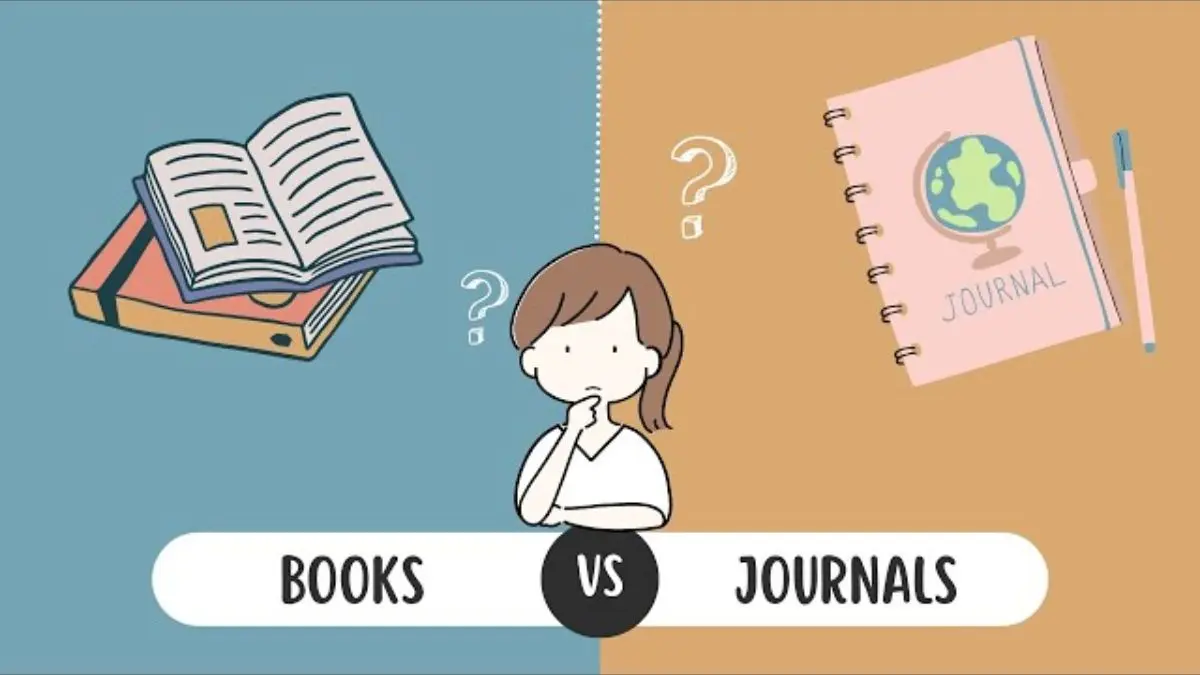In the rich landscape of informational resources, books and journals serve as fundamental yet distinctly different mediums, catering to varied audiences and purposes. This blog “Difference Between Books and Journals” delves into these differences, highlighting how each is structured, utilized, and valued across academic, professional, and personal contexts. Understanding whether to reference a book or a journal can significantly influence the depth and scope of research for students, ensure accuracy for professionals, and enhance enjoyment for casual readers. Through exploring definitions, audiences, content, Authorship and Authority, and more, this piece aims to equip readers with the knowledge to effectively navigate and utilize both books and journals in their information-seeking endeavors.
Difference Between Books and Journals
Definition and Basic Characteristics
Books: A book is a written or printed work consisting of pages glued or sewn together along one side and bound in covers. Books cover a wide range of topics and are typically a work of fiction, non-fiction, or academic scholarship. They are characterized by a cohesive narrative or thematic organization that provides in-depth coverage of a topic in a structured format. Books can be published in various formats, including hardcover, paperback, or electronic versions (e-books), and are designed for a broad readership.
Journals: A journal is a periodical publication that focuses on a specific academic field or professional industry, presenting new research, findings, and discussions. Journals are usually published on a regular schedule (monthly, quarterly, etc.) and contain a series of articles written by experts in the field. Each article in a journal is often peer-reviewed, meaning it has been evaluated and critiqued by independent scholars or experts before publication. Journals are primarily intended for academic or professional audiences and are crucial in disseminating current research and scholarly discussions.
Basic Characteristics:
- Format and Presentation: Books are typically longer and cover a topic comprehensively, while journal articles are shorter, focusing on specific studies or issues within a broader field.
- Authorship: Books may be written by one or more authors, focusing on the authors’ individual perspectives or research; journals contain articles by multiple authors, emphasizing a collaborative and often interdisciplinary approach.
- Publication Cycle: Books are usually published once as a complete work (though they may be reprinted), whereas journals are published at regular intervals, continually presenting the latest research.
- Target Audience: Books aim to reach a general or broadly interested audience, including specialists and non-specialists alike; journals are targeted more towards specialists, researchers, and professionals in specific academic or professional fields.
Purpose and Audience

Purpose of Books: Books are typically created to provide comprehensive knowledge or narratives on a wide range of subjects. The purposes of books can vary significantly depending on their type:
- Educational books are designed to teach and inform on academic or practical subjects.
- Fictional books aim to entertain and provide an escape through stories and imaginative worlds.
- Non-fiction books seek to inform or persuade through factual, well-researched content on topics such as history, science, and philosophy.
- Reference books serve as a resource for specific information, offering quick, direct access to focused facts or data.
Audience for Books: Books are intended for a diverse audience, ranging from the general public to specialized professionals or academics, depending on the subject matter and the complexity of the content. Children, young adults, and adults all have books specifically tailored to their interests and reading levels. Some books are meant for broad consumption, while others are targeted towards niche audiences with specialized knowledge or interests.
Purpose of Journals: Journals serve primarily as a platform for the dissemination of research and scholarly ideas within the academic and professional communities. They aim to:
- Advance research by publishing new discoveries and insights.
- Facilitate scholarly communication among professionals and academics by sharing research outcomes and methodologies.
- Validate research through peer review, ensuring the reliability and academic integrity of the published work.
- Record academic progress over time in various disciplines.
Audience for Journals: The primary audience for journals is professionals, researchers, and academics within specific fields. Journals cater to readers who have a strong foundation in the topic at hand and are looking for the latest research or comprehensive reviews on advanced topics. This audience values the detailed analysis, empirical data, and critical discussions that journals provide. Additionally, students at the undergraduate and graduate levels frequently consult journals for the latest research to support their studies and papers.
Content and Scope
Content of Books: The content of books can be incredibly varied, encompassing everything from in-depth scholarly works to light, entertaining fiction. Books typically provide:
- Comprehensive Exploration: Books often explore topics in depth, providing detailed background, extended analysis, and thorough discussion. This allows authors to develop complex ideas, narratives, or characters extensively.
- Diverse Genres: Books include a multitude of genres such as novels, biographies, textbooks, self-help, and many others, catering to a wide array of interests and needs.
- Standalone or Series Format: While many books are complete as standalone works, some are part of a series that develops a theme or story across multiple volumes, which allows for an evolving exploration of subjects or characters.
Scope of Books: Books are designed to cover topics from the general to the highly specialized, with scopes varying widely:
- Broad Scope: General interest books cover topics in a way that is accessible to a wide audience, often providing general knowledge or introductions to subjects.
- Specialized Scope: Academic or technical books delve deeply into specific topics, offering detailed and sophisticated analysis intended for readers with a background in the subject.
Content of Journals: Journals consist of articles that are typically concise and focused on specific research questions or hypotheses. They include:
- Original Research Articles: These provide detailed reports on new research, including methodology, data, results, and conclusions.
- Review Articles: These summarize and synthesize existing research on a particular topic, often identifying trends, evaluating progress, or suggesting areas for future research.
- Case Studies and Reports: In fields like medicine or psychology, journals may include detailed accounts of individual cases or specific events.
Scope of Journals: The scope of journal content is generally narrow, focusing on advancing knowledge within a particular discipline:
- Focused Scope: Each article addresses a specific aspect of a larger field, contributing to a cumulative understanding of the subject.
- Current and Timely: Journals aim to publish the latest findings and discussions, reflecting ongoing debates and advancements in the field.
Authorship and Authority

Authorship in Books:
- Individual or Collaborative Efforts: Books can be written by a single author or by multiple authors collaborating on the project. The approach depends on the nature of the book; for example, academic textbooks or anthologies often have multiple contributors.
- Expertise and Perspective: Authors of books often bring their unique perspective or expertise to the subject matter, which can shape the content significantly. This individual approach allows for a diverse range of voices and interpretations within various genres.
- Recognition and Credibility: The credibility of a book often hinges on the reputation and credentials of the author(s), especially in non-fiction genres. Well-known authors in specific fields can lend authority to the topics discussed in their books.
Authority in Books:
- Editorial Process: Books go through an editorial process where editors help refine content, ensure accuracy, and improve readability. However, the depth of fact-checking and peer review is generally less rigorous than that found in journal publications.
- Publishing Standards: The authority of books also depends on the publisher’s standards and the editorial processes they enforce. Established publishers are known for maintaining high standards, which enhances the book’s credibility.
Authorship in Journals:
- Contributions from Multiple Experts: Journal articles are often authored by multiple contributors, reflecting the collaborative nature of research. This includes primary researchers, co-researchers, and sometimes large teams in fields like science and engineering.
- Peer Review Process: Unlike most books, journal articles undergo a rigorous peer review process where other experts in the field evaluate the research for validity, significance, and originality. This critical evaluation is a key aspect of scholarly publishing.
Authority in Journals:
- Credibility Through Peer Review: The authority of journal articles is significantly enhanced by the peer review process, which helps ensure that the research is accurate, reliable, and a valuable addition to the field.
- Impact Factor: The authority of a journal can also be assessed by its impact factor—a measure reflecting the average number of citations to recent articles published in the journal. High impact factors are often seen as indicators of high scholarly value.
Conclusion
We’ve uncovered distinct characteristics that define each medium’s unique role in the dissemination of information and knowledge. Books offer a broad and often in-depth exploration of topics, suitable for a wide range of readers from casual enthusiasts to experts seeking comprehensive overviews. They serve as enduring resources that cater to both educational and entertainment needs, authored by experts or literary talents who provide personal insights or narrative experiences.
On the other hand, journals are quintessential for academic and professional communities, presenting cutting-edge research and detailed studies through articles that undergo rigorous peer review. This process ensures that the information is not only current but also scientifically valid, making journals indispensable for professionals and researchers who need to stay informed about the latest developments in their fields.
Also Read: Difference Between Fantasy and Fairy Tale



